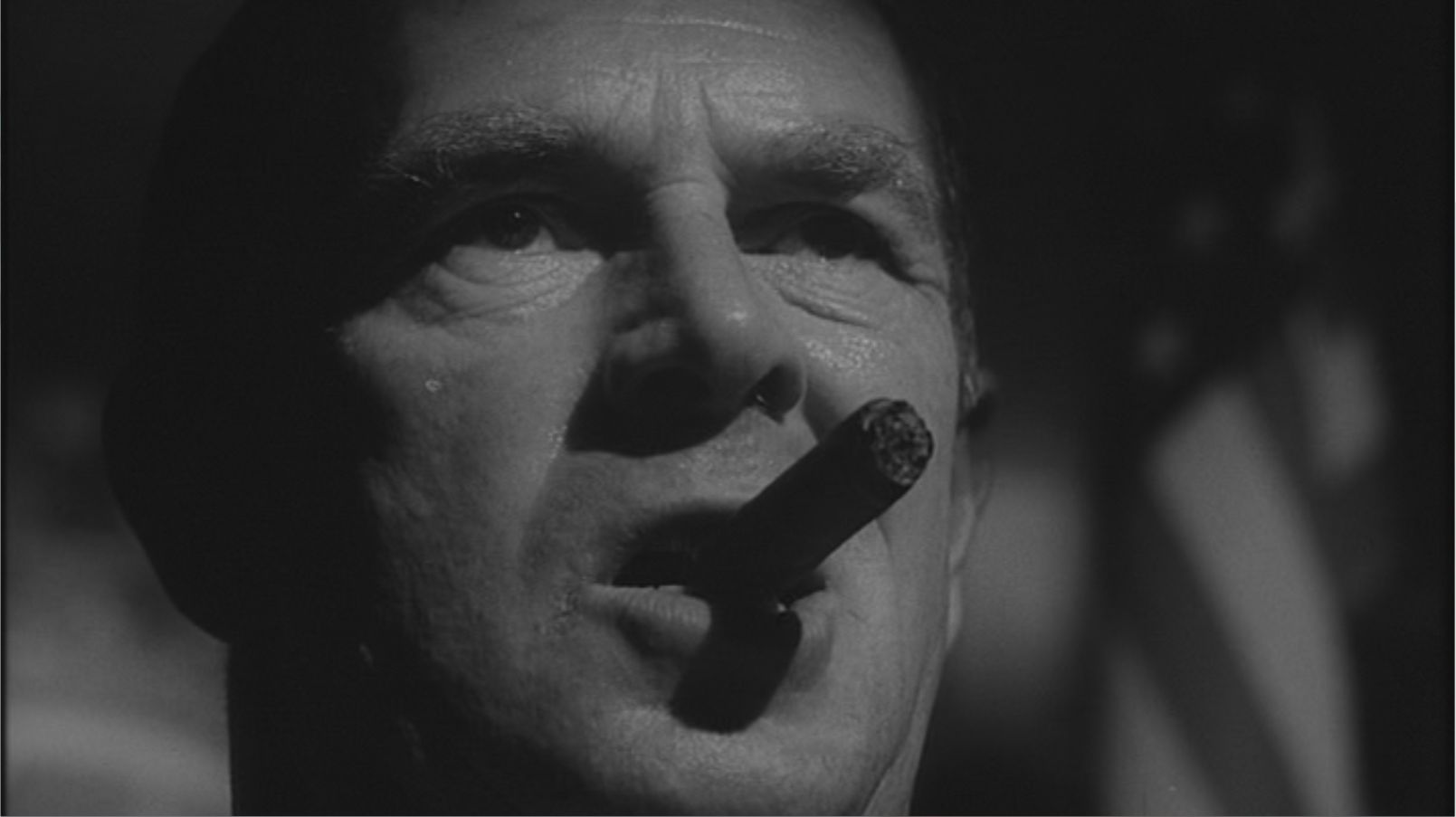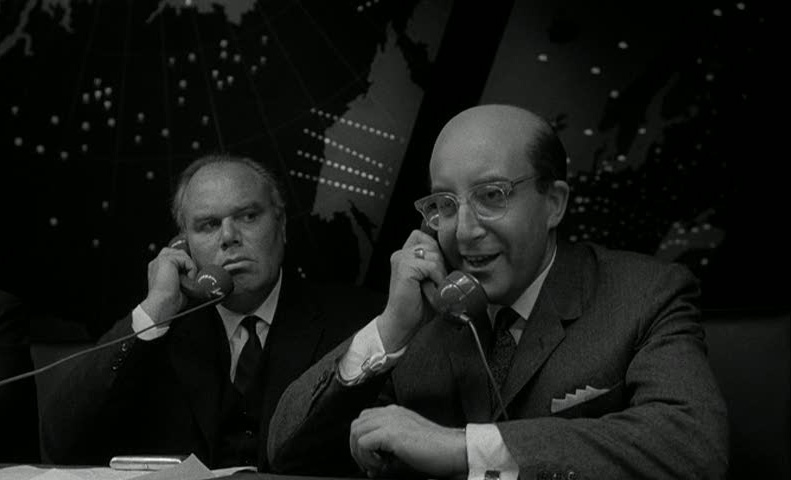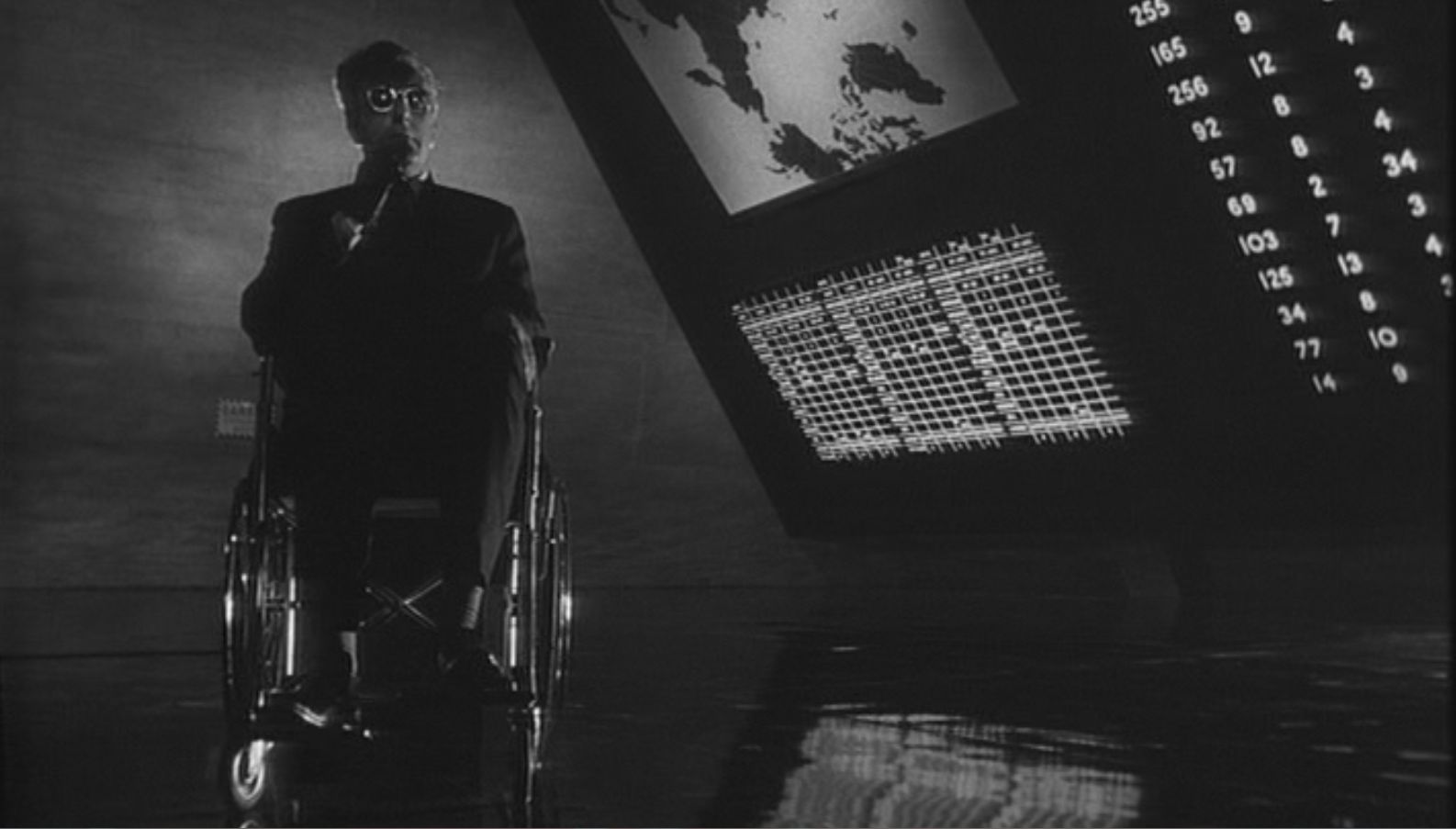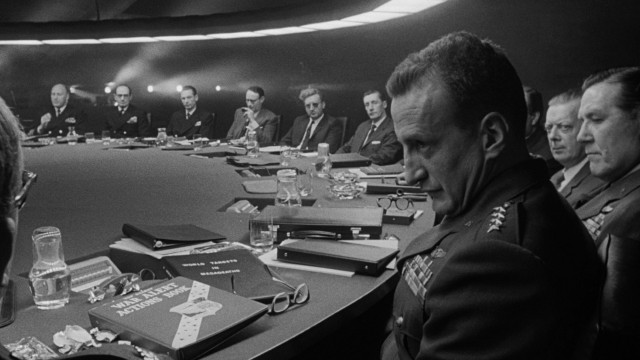I am troubled by the feeling which runs all through the film, of discredit and even contempt for our whole defense establishment, up to and even including the hypothetical commander in chief. . . .when virtually everybody turns up stupid or insane–or what is worse, psychopathic–I want to know what this picture proves. (Bosley Crowther, chief film critic, The New York Times, 1964)
In this series, I’ve been using the term iconic as praise for Kubrick’s work without really explaining what it means, and Dr. Strangelove, or How I Learned to Stop Worrying and Love the Bomb, probably his most iconic work (The Shining and 2001 are the only other contenders) gives a good opportunity to do that. Often, I use iconic in opposition to naturalistic. Naturalistic acting and filming implies that it’s something we could see in our everyday lives, and iconic definitely does not mean that. However, iconic can’t simply mean “unrealistic”; there’s lots of unrealistic stuff that has no impact, that just comes off as bad acting or filmmaking. So what makes something iconic?
Charles Bukowski said that the important thing to write is “the obvious thing no one is talking about,” and that leads to perhaps the best definition of the iconic: it’s the real thing we never get to see. Living through the Cold War, you knew there had to be people like Gen. Buck Turgidson, President Merkin Muffley, Gen. Jack D. Ripper, Col. Bat Guano, Maj. King Kong, Group Captain Lionel Mandrake, and Dr. Strangelove himself. (Another way you spot an iconic character? You start by looking at the ones with the funny names, and yes I stole that line from the Coen Bros., two more creators of icons.) Art can make us see things in our world that were always there by giving us ideal types to look for; arguably, this is a fundamental pattern of human thinking. It’s what we mean by theory, and what Plato meant with his theory of the Forms; that those Forms were the most real things, and the world we lived in was made by the Shadows of the Forms. Iconic characters, then, are the Forms of real people. Dr. Strangelove isn’t that far off from Herman Kahn, and Buck Turgidson could be Curtis LeMay, who advised bombing Vietnam “back to the Stone Age.” That’s why iconic characters have a life to them and they go beyond the bounds of their work. They live on in our collective memory, because they live on in our collective world.
Writing, directing, and playing iconic requires different skills and approaches than naturalism. Billy West, describing his approach to voicing Richard Nixon on Futurama (AROOOO!), said he learned not to try to imitate Nixon, but to find one aspect of Nixon’s voice and hit that hard. That’s iconic performing, and it’s not a criticism to call it “one-note”; it’s about finding that note and hitting it exactly. Keeping this analogy going, a one-note performance isn’t a problem, but a one-note film is. To Strangelove’s benefit, all the iconic players hit different but harmonious notes here and give Kubrick a full, rich mode of crazy for composing. Joan Didion criticized Strangelove for “developing a full fugue on the theme” of “the difference between all other wars and nuclear war” in the first twenty minutes, but Kubrick keeps the fugue going with additional themes of sexuality and politics, and throws in a lot of gags as ornaments around those melodies. (BOOM! Come at wallflower with the musical metaphors, you best not miss.)
The Form Kubrick (and the actors and co-screenwriter Terry Southern) illuminated here was one he looked at his entire career, but never more than in this: reason as a form of madness, especially in men. Reason-as-madness comes from following a step by step process of thinking until you arrive at something totally fuckin’ insane. It allows the thinker to never face the insanity, because there’s that process that says “see, this is what I had to do.” What characterizes reason-as-madness isn’t the craziness of the end result, it’s the way that craziness gets perfectly justified.
That’s what Crowther saw, and didn’t get; he knew something was happening but he didn’t know what it was. The Cold War had been going on for almost twenty years at the time of Strangelove’s release, long enough for its essential insanity (you attack me and we both blow up the world) to take root and develop its own logic, a logic that was unquestioned by the American establishment. (Crowther saw himself and The New York Times as part of that establishment, and 1964 was about the last year that word could be used positively.) Communism was a pure, viral form of evil that was going to infect the world, possibly through the water supply (Ripper’s fear of fluoridation was a real thing); the only way to stop them was to be tougher than they were; and who ever had the fewest people die in a nuclear war, wins–and that was something you could calculate. (Note Turgidson’s “World Targets in Megadeaths” binder.) Everyone does turn up stupid or insane in Strangelove, because they have all accepted a stupid, insane system. Within that system, they are all making completely rational, logical steps that lead to the world blowing up in the last moments of the film. It’s the trial scene in Paths of Glory, but played all the way to the end of civilization, and here there’s no Colonel Dax to show the way to rational behavior. (This came out of a conversation with scb0212 in the Paths comments.)
Writing and directing can only do so much to make an iconic character; the performers have to bring it, too, and everyone here does, whether it’s Keenan Wynn hitting the word “preversion” or Slim Pickens’ yodeling (this and Blazing Saddles assure his position in the Pantheon of Comedy Gods) or Tracy Reed on the phone or Sterling Hayden monologuing about purity of essence. (By the way, I’m skipping the discussion of the theme of sex here simply because it’s been so thoroughly written and discussed elsewhere, reaching a kind of, um, climax when Hugh Hefner introduced a showing of Strangelove on TNT’s “Movies We Love” back in the 1990s.) Hayden works a cigar like he’s conducting an orchestra, and there’s a sadness to his performance, especially in the last scene, that isn’t necessary for the film but deepens it.  Like his Johnny Clay, his Gen. Ripper always knew how it had to end. Peter Sellers crushes all three of his roles (an injury kept him from playing Pickens’ character too); President Muffley (“oh”) and Strangelove himself are the most remembered, but his Group Captain Lionel Mandrake is their equal, with the stiffest upper lip possible. (“Oh hell” is his reaction to war.) He’s worried about global apocalypse, you see, but he’s not going to allow himself to get too upset about it. He’s also completely sure of his superiority to Americans.
Like his Johnny Clay, his Gen. Ripper always knew how it had to end. Peter Sellers crushes all three of his roles (an injury kept him from playing Pickens’ character too); President Muffley (“oh”) and Strangelove himself are the most remembered, but his Group Captain Lionel Mandrake is their equal, with the stiffest upper lip possible. (“Oh hell” is his reaction to war.) He’s worried about global apocalypse, you see, but he’s not going to allow himself to get too upset about it. He’s also completely sure of his superiority to Americans.
An iconic performance can be measured by how unforgettable it is; a performer risks doing something so strong and permanent that we can never see him or her as anything else, and I just cannot see George C. Scott as a dramatic actor after this film. His Gen. Buck Turgidson is a cartoon performance in the best sense, switching facial expressions and postures like he’s in The Emperor’s New Groove, going absolutely bug-eyed at times, giggling with the sheer fun of nuclear war, and has anyone tried to count how much gum he chews through the entire film? (The one detail I remember from 1996’s Godzilla was Jean Reno chewing gum because “it makes us look more American.”) He’s the funniest and most iconic guy here against the toughest comic competition imaginable.
Iconic works tend to be so very quotable, and Dr. Strangelove may be the most quotable movie ever. What makes for a good quote is the sense that what’s being said can’t be said any better; it’s what Don deLillo meant when he said “there’s a moral force to a sentence when it comes out right.” That force comes from the performance, too; a good movie quote has to be said with the same inflection and cadence as it was said in the movie. Every word and hesitation counts, as in a great line of music. The only movies as quotable as Strangelove are The Big Lebowski and The Adventures of Buckaroo Banzai; the latter shares a lot of the tone and humor as Strangelove—Banzai’s Secretary of Defense in particular. I’m also pretty sure President Muffley has copy of the Declaration of War: the Short Form somewhere in his binder.
We all have our favorite quotes; mine is usually Turgidson’s “Mr. President, I’m not saying we wouldn’t get our hair mussed. But I am saying no more then ten, twenty million dead. Uh, depending on the breaks.” It’s the sheer enthusiasm that Scott loads into the line that makes it work, and the little “uh” too, because you know he’s thinking “better not promise too much there, Bucky boy.” It’s absurd and it’s funny and it’s everything Strangelove is about in a single line. There are also some other lines that will forever reduce me to helpless giggles, like even while I’m typing them: “ice cream, Mandrake. Children’s ice cream”; “the bomb, Dmitri. The hydrogen bomb”; “animals could be bred und shlaughtered”; and, inexplicably, “just ask for Omsk Information.”
As much as Edgar Wright in the Cornetto Trilogy (Shaun of the Dead, Hot Fuzz, The World’s End), Kubrick knows the value of placing this comedy within the tight structure of a thriller. Kubrick paces Strangelove as tightly as Paths of Glory or The Killing, and with as much of a noir sense of inescapability. Kubrick launches the plot immediately after the titles with Ripper’s order to attack, and it keeps going until the end. This is another movie where Kubrick strategically deploys the voiceover; its presence in the first ten minutes makes this feel like it will be a standard military thriller. His sense of pace has gotten more precise and merciless; the drums in Laurie Johnson’s score and his use of “When Johnny Comes Marching Home” make this feel like an hourlong version of the death march from Paths of Glory. Another effective move by Kubrick, one that he’ll use again in 2001, is how he spends so much time in Maj. Kong’s bomber, observing technical details one by one. That contributes to the feeling of relentless pacing, reinforces the sense of a step-by-step, inexorable process, and most importantly, pays off in the one moment at the end when the process doesn’t work and the bomb bay doors don’t open.
Strangelove was a watershed movie, bringing the first half of Kubrick’s career to a close. This film was made entirely in England, and no matter the setting of the story, he would never make another film outside of there again. His productions would grow more careful and elaborate, and his films would get longer. To this point, Kubrick made seven films in eleven years (and scored two masterpieces); after Strangelove, he made six films in thirty-five years. All but two of those first seven films were under 95 minutes in length and only one was in color; all but one (Full Metal Jacket) of the next six were over two hours, and Kubrick never went back to black-and-white again.
It’s rare that history can give you results as clear as a scientific experiment, but in this case the impact of Strangelove can be measured against another 1964 movie, Sidney Lumet’s Fail-Safe. It has the same overall plot as Strangelove (unintentional nuclear attack on the Soviet Union leads to disaster), many of the same beats (hot line to the Russian premier, US assists Russia in shooting down the bombers), Walter Matthau plays the Herman Kahn character but plays him straight, and it hasn’t lasted in popular memory–George Clooney’s live production of it back in 2000 pretty much tanked. Strangelove has not become dated or faded from our collective memory. The Cold War has ended, but our species still has developed our rationality and underdeveloped our morality to the point where we can wipe ourselves out, and sing a perfect justification for doing so.
Man is not evil, they say. He is simply too hilariously stupid to survive.
And this I believe.
Cheers. (Kurt Vonnegut)
Previously: Lolita (1962)
Next: 2001: A Space Odyssey (1968)

